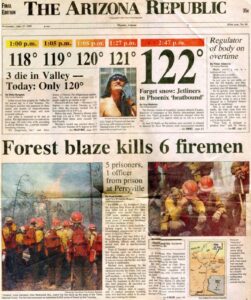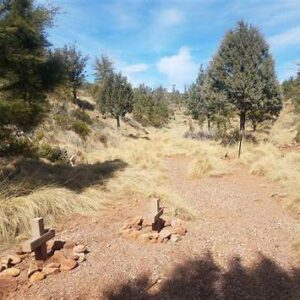DUDE FIRE —Thirty-five years ago today, one of Arizona’s deadliest wildfires ignited near the Mogollon Rim, forever changing the landscape and the future of wildland firefighting.
The Dude Fire, sparked by a dry lightning strike on June 25, 1990, began in the rugged terrain northeast of Payson. Fanned by high winds, the blaze exploded from just a few acres to more than 24,000 acres in less than 48 hours. In its path lay thick pine forests, remote canyons, and the small communities of Bonita Creek Estates and Pyle Ranch.
Within a day, the fire had destroyed more than 60 homes, including the historic Zane Grey Cabin, and pushed through parts of both the Tonto and Coconino National Forests. But the greatest loss came on June 26, when six firefighters-five inmate crew members from Perryville Prison and their supervisor—were overrun and killed by a sudden, fast-moving wall of flame in Walk Moore Canyon. Four firefighters were also injured.
The summary of the Dude Fire incident.

Those who lost their lives included:
-
Sandra JoAnn Bachman, Assistant to the Deputy Warden, Arizona Department of Corrections
-
Joseph L. Chacon, Inmate Firefighter-Perryville Fire Crew
-
Alex S. Contreras, Inmate Firefighter-Perryville Fire Crew
-
James L. Denney, Inmate Firefighter-Perryville Fire Crew
-
James E. Ellis, Inmate Firefighter-Perryville Fire Crew
-
Curtis E. Springfield, Inmate Firefighter-Perryville Fire Crew

Sandra JoAnn Bachman, who served as Assistant to the Deputy Warden at the Arizona Department of Corrections, was a dedicated public servant who worked tirelessly to ensure the safety and well-being of others. Tragically, she lost her life while supervising the inmate crew fighting the Dude Fire. Bachman’s role in the firefighting effort was vital, and the state of Arizona deeply mourned her passing, as well as that of the five members of the Perryville Fire Crew.

Bachman was posthumously honored with a memorial at Perryville State Prison, and her name continues to be remembered as a symbol of courage and sacrifice. Sandra is among those commemorated at the memorial site in Walk Moore Canyon, where her legacy, along with that of the other fallen firefighters, endures.
The tragedy marked the deadliest wildfire incident in Arizona at the time, leading to widespread investigations and calls for reform. Poor communication, a lack of real-time weather updates, and inadequate escape plans were all identified as contributing factors.
In the months and years that followed, the Dude Fire became a case study in wildland firefighting. Training manuals were rewritten. Safety policies were overhauled. The incident directly contributed to the nationwide adoption of the L.C.E.S. protocol—a system emphasizing Lookouts, Communications, Escape Routes, and Safety Zones. It also reinforced the mandatory use of fire shelters, which, though issued at the time, were not deployed by the fallen crew.
Today, the fire’s legacy is visible not only in the burned scars that still mark the landscape but in how wildland fires are fought across the country. The U.S. Forest Service and state agencies now regularly conduct staff rides, where crews walk through historic incident sites to learn firsthand about lessons learned.
Ecological restoration is also ongoing. The Dude Fire Restoration Project, launched in recent years, has reforested much of the affected area with native ponderosa pine and installed erosion control systems to protect sensitive watersheds. Controlled burns and fuel-thinning operations now play a regular role in forest maintenance, particularly as Arizona faces longer, hotter fire seasons.
For residents of Payson, the Rim Country, and Arizona, the memory of the fire remains vivid. Each year on the anniversary, a small group gathers at the memorial site in Walk Moore Canyon—a quiet clearing now shaded with regrowth and framed by a stone monument bearing the names of the fallen.
As wildfires become more intense and frequent across the West, many see the Dude Fire not as a historical footnote, but as a warning—one that continues to guide decisions made in state and federal firefighting strategies.

